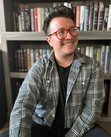Gabe Cole Novoa's Blog, page 57
July 27, 2015
Fixing the First Page #13
 Photo credit: zubrow on FlickrSomehow, we’re nearing August, which is somewhat terrifying and also how is this summer nearly over? Yeesh.
Photo credit: zubrow on FlickrSomehow, we’re nearing August, which is somewhat terrifying and also how is this summer nearly over? Yeesh. Anyway! We’ve got this month’s first page critique all set up! As these things go, I'll start by posting the full first 250 excerpt, after which I'll share my overall thoughts, then my redline critique. I encourage you guys to share your own thoughts and critiques in the comments (I'm just one person with one opinion!), as long as it's polite, thoughtful, and constructive. Any rude or mean comments will be unceremoniously deleted.
Here we go!
Title: STARBOUND
Genre/Category: Adult Fantasy
First 250:
“Evening memos never brought good news, and I could smell one in my mailbox. The once beloved sweet, gassy smell of barrel-printing was now the odor of tightened belts and knotted purses. I picked up the page and hissed as the edge sliced the pad of my little finger.
I sucked my finger and read an order to discharge 30% of my Mental Recovery patients by next week, to prepare for the legions of soldiers returning home from the war. I'd have to choose as if anyone in a bed now was staying in a hospital for the cuisine and ambiance. Who was too mad to leave? Who was sane enough to go?
I stuffed it in my coat pocket, jogging downstairs and out the front door.
An Autumn breeze kissed my cheeks, a friend I hadn't met in years. The evening air had a streak of Winter in it, a promise of frost on the grass in the morning and nothing at all of Laneer's everlasting Summer and gunfire. Home. For a moment I believed it. I'm home.
The heavy door of the hospital swung shut behind me. I lit a cigarette and curled my hand around it to hide the tell-tale light of the burning end, shifted to put a graystone pillar between me and the tree with the best line of sight to the front door. I grimaced at my foolishness, but the band of tension along my shoulders eased.
Sixteen men. I had to choose them and send them home.”
What an interesting start! Overall, I think this is really well-written, and I like the tension we get right from the first sentence. The conflict is established right away, we get a hint of world building without an info dump and we feel right away for the protagonist, who seems to be a decently nice person stuck in a tough situation. The main tweaks I’m noticing are in-line adjustments (and small ones at that), so I think this is pretty good shape. :)
Let’s take a look at in-line edits:
“Evening memos never brought good news, and I could smell one in my mailbox. Not a huge deal here, because it kind of works, but I still think this could be more visual if the filter phrase was removed and the sentence was re-worded slightly. The once beloved sweet, gassy smell of barrel-printing was now the odor of tightened belts and knotted purses. Great imagery, here. Very evocative. I picked up grabbed the page and hissed as the edge sliced the pad of my little finger.
I sucked my finger and read an —the order read to discharge 30% of my Mental Recovery (Is this capitalized for a reason?) patients by next week, to prepare for the legions of soldiers returning home from the war. I'd have to choose as if anyone in a bed now was staying in a hospital for the cuisine and ambiance. Who was too mad to leave? Be careful with the implication of craziness—having a mental illness/disorder does not equate to being crazy, and a lot of people take offense to the implication/stereotype. It's not a great thing to perpetuate. Who was sane enough to go?
I stuffed it in my coat pocket, jogging downstairs and out the front door.
An Autumn breeze kissed my cheeks, a friend I hadn't met in years. Is there a book-related reason the seasons are capitalized? I’m not sure. The evening air had a streak of Winter in it, a promise of frost on the grass in the morning and nothing at all of Laneer's everlasting Summer and gunfire. Home. GREAT world building here, and I absolutely love the imagery of an everlasting summer and gunfire. Gorgeous. For a moment I believed it. I'm home.
The heavy door of the hospital swung shut behind me. I lit a cigarette and curled my hand around it to hide the tell-tale light of the burning end,. I shifted to put a graystone pillar between me and the tree with the best a direct line of sight to the front door. I grimaced at my foolishness, I’d like to see this reworded a bit. Why is it foolishness? Is her smoking outside foolish? Hiding behind the pillar foolish? What exactly is going on in her head? If we can see her chastising herself internally with some thoughts, it’d be much even more powerful than what you have here. but the band of tension along my shoulders eased. This is nice, though. I like this.
Sixteen men. I had to choose them and send them home.” What will happen to the men she sends home prematurely? I think it’d be good to get a hint of that in here somewhere, just so we truly understand the stakes.
Overall, as I said, I think this is really well done and the tweaks are minor. If you’re careful with wordiness and give us a bit more of a hint on the stakes at play here, I think you’ll be completely set with this first 250. If I saw this in the slush, I’d keep reading!
I hope this helps! Thanks for sharing your first 250, Angela!
Would you like to be featured in a Fixing the First Page Feature? Keep an eye out for the next giveaway!
Twitter-sized bite:
.@Ava_Jae talks vivid imagery and setting the stakes in the 13th Fixing the First Page critique. (Click to tweet)





Published on July 27, 2015 04:00
July 24, 2015
A Basic Genre Index (Part Two)
So part one of the genre index was a success! And I promised you guys part two, so here it is. I know this doesn’t cover every genre ever (there are wayyyyyyy too many, especially if you go into subgenres and subgenres of subgenres!) but I do think these two posts cover the major ones. I hope.
Enjoy!
Mystery
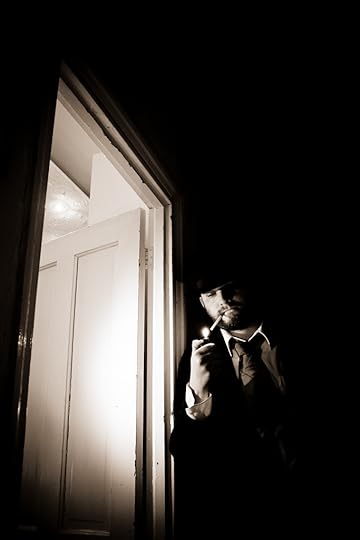 Photo credit: practicalowl on Flickr
Photo credit: practicalowl on Flickr
Oftentimes (though not always), these involve a body and figuring out who is behind it. Sometimes it’s many bodies. Often it features the detective (whether an actual detective or someone just taking on the role of detective) trying to solve the case. These tend to be spooky and exciting and usually end with a confrontation between the killer and the protag and sometimes blend with Thrillers. Even when it doesn’t involve a killer though, there is some kind of mysterious circumstance that the protagonist is trying to puzzle out. And the stakes are often high.
Examples: The Good Girl by Mary Kubica, The Cuckoo’s Calling by Robert Galbraith, Vanishing Girls by Lauren Oliver, The Dead Key by D.M. Pulley, All the Little Pieces by Jilliane Hoffman, Charlie, Presumed Dead by Anne Heltzel. (Others)
Historical Fiction
 Credit: Sweet Carolina Photography (Flickr)
Credit: Sweet Carolina Photography (Flickr)
As the title would suggest, this is fiction that takes place in the past—the real past, that is. (Otherwise you’re talking Historical Fantasy, which is related, but not quite the same.) The past can be anything from BC times to medieval times, to Tudor-era or Regency or something else. Generally, it’s a time period that’s considered historical though, and of course the story that takes place isn’t true.
Examples: The Help by Kathryn Stockett, The Book Thief by Markus Zusak, Fever 1793 by Laurie Halse Anderson, Atonement by Ian McEwan, The Boy in the Striped Pajamas by John Boyne, The Kite Runner by Khaled Hosseini,
Contemporary Romance
 Photo credit: Stephen Burch on Flickr
Photo credit: Stephen Burch on Flickr
This is romance that takes place today! In our world. With no supernatural creatures or superpowers. Romance is at its heart (as opposed to non-romance Contemporary), and these are stories that could actually happen.
Examples: Trust the Focus and Make It Count by Megan Erickson, Under the Lights by Dahlia Adler, The Summer of Chasing Mermaids by Sarah Ockler, Days Like This by Danielle Ellison, Second Position by Katherine Locke, The Fault in Our Stars by John Green, When We Collided by Emery Lord, The Sound of Us by Ashley Poston, The Night We Said Yes by Lauren Gibaldi, Last Year’s Mistake by Gina Ciocca, Hello, I Love You by Katie M. Stout, The Revenge Playbook by Rachael Allen, To All the Boys I’ve Loved Before by Jenny Han. (Others)
For more info on writing (NA) contemporary romances, check out this post.
Erotica
 Photo credit: Bert Werk on Flickr
Photo credit: Bert Werk on Flickr
This is romance that is super steamy and explicit. The focus, here, is the sex. Without the sex, there isn’t a story (unlike most Romances where sex emphasizes the story, but the story wouldn’t fall apart without it, necessarily). If you’re looking for a sexy read that doesn’t spare any details, this is where you want to go.
Examples: Changing His Game by Megan Erickson, Beautiful Bastard by Christina Lauren, Fifty Shades of Grey by E.L. James, Rush by Maya Banks, Up in Smoke by Tessa Bailey, The Best Laid Plans by Tamara Mataya, Strings by Kendall Grey, Crash into You by Roni Loren, The Siren by Tiffany Reisz, Fast, Fresh, and Hot by Eliza Madison. (Others)
Contemporary
 Photo credit: Laura4Smith on Flickr
Photo credit: Laura4Smith on Flickr
Like Contemporary Romance, these books in our world and could actually happen—the difference is that the romance (if there is one) isn’t necessarily the glue that holds everything together. These books cover other issues that are the point and may or may not have a romantic subplot (versus a romantic main plot). They also tend to be really voice-heavy and memorable for the writing itself.
Examples: I’ll Give You the Sun by Jandy Nelson, Fangirl by Rainbow Rowell, None of the Above by I.W. Gregorio, Made You Up by Francesca Zappia, Tiny Pretty Things by Sona Charaipotra and Dhonielle Clayton, Everything, Everything by Nicola Yoon, Between the Notes by Sharon Huss Roat, Love May Fail by Matthew Quick. (Others)
Magical Realism
 Photo credit: martinak15 on Flickr
Photo credit: martinak15 on Flickr
So this is probably the hardest one to define. The way I understand it, Magical Realism is similar to Contemporary in that it usually takes place in a world very much like our own, but there’s an extra something that couldn’t be real. Maybe the something is a curse, or a chance to re-do your day, or a magical substance in an otherwise normal town. Think of it as Contemporary with a twist—but the twist can’t be so huge that it becomes Paranormal or Fantasy. It’s a fine line.
Examples: Glory O’Brien’s History of the Future by A.S. King, The Status of All Things by Liz Fenton and Lisa Steinke, The Strange and Beautiful Sorrows of Ava Lavender by Leslye Walton, Belzhar by Meg Wolitzer, One Hundred Years of Solitude by Gabriel García Márquez, The Night Circus by Erin Morgenstern, The House of Spirits by Isabel Allende, Landline by Rainbow Rowell, Every Day by David Levithan, Bone Gap by Laura Ruby. (Others)
Twitter-sized bites:





Enjoy!
Mystery
 Photo credit: practicalowl on Flickr
Photo credit: practicalowl on FlickrOftentimes (though not always), these involve a body and figuring out who is behind it. Sometimes it’s many bodies. Often it features the detective (whether an actual detective or someone just taking on the role of detective) trying to solve the case. These tend to be spooky and exciting and usually end with a confrontation between the killer and the protag and sometimes blend with Thrillers. Even when it doesn’t involve a killer though, there is some kind of mysterious circumstance that the protagonist is trying to puzzle out. And the stakes are often high.
Examples: The Good Girl by Mary Kubica, The Cuckoo’s Calling by Robert Galbraith, Vanishing Girls by Lauren Oliver, The Dead Key by D.M. Pulley, All the Little Pieces by Jilliane Hoffman, Charlie, Presumed Dead by Anne Heltzel. (Others)
Historical Fiction
 Credit: Sweet Carolina Photography (Flickr)
Credit: Sweet Carolina Photography (Flickr)As the title would suggest, this is fiction that takes place in the past—the real past, that is. (Otherwise you’re talking Historical Fantasy, which is related, but not quite the same.) The past can be anything from BC times to medieval times, to Tudor-era or Regency or something else. Generally, it’s a time period that’s considered historical though, and of course the story that takes place isn’t true.
Examples: The Help by Kathryn Stockett, The Book Thief by Markus Zusak, Fever 1793 by Laurie Halse Anderson, Atonement by Ian McEwan, The Boy in the Striped Pajamas by John Boyne, The Kite Runner by Khaled Hosseini,
Contemporary Romance
 Photo credit: Stephen Burch on Flickr
Photo credit: Stephen Burch on FlickrThis is romance that takes place today! In our world. With no supernatural creatures or superpowers. Romance is at its heart (as opposed to non-romance Contemporary), and these are stories that could actually happen.
Examples: Trust the Focus and Make It Count by Megan Erickson, Under the Lights by Dahlia Adler, The Summer of Chasing Mermaids by Sarah Ockler, Days Like This by Danielle Ellison, Second Position by Katherine Locke, The Fault in Our Stars by John Green, When We Collided by Emery Lord, The Sound of Us by Ashley Poston, The Night We Said Yes by Lauren Gibaldi, Last Year’s Mistake by Gina Ciocca, Hello, I Love You by Katie M. Stout, The Revenge Playbook by Rachael Allen, To All the Boys I’ve Loved Before by Jenny Han. (Others)
For more info on writing (NA) contemporary romances, check out this post.
Erotica
 Photo credit: Bert Werk on Flickr
Photo credit: Bert Werk on FlickrThis is romance that is super steamy and explicit. The focus, here, is the sex. Without the sex, there isn’t a story (unlike most Romances where sex emphasizes the story, but the story wouldn’t fall apart without it, necessarily). If you’re looking for a sexy read that doesn’t spare any details, this is where you want to go.
Examples: Changing His Game by Megan Erickson, Beautiful Bastard by Christina Lauren, Fifty Shades of Grey by E.L. James, Rush by Maya Banks, Up in Smoke by Tessa Bailey, The Best Laid Plans by Tamara Mataya, Strings by Kendall Grey, Crash into You by Roni Loren, The Siren by Tiffany Reisz, Fast, Fresh, and Hot by Eliza Madison. (Others)
Contemporary
 Photo credit: Laura4Smith on Flickr
Photo credit: Laura4Smith on FlickrLike Contemporary Romance, these books in our world and could actually happen—the difference is that the romance (if there is one) isn’t necessarily the glue that holds everything together. These books cover other issues that are the point and may or may not have a romantic subplot (versus a romantic main plot). They also tend to be really voice-heavy and memorable for the writing itself.
Examples: I’ll Give You the Sun by Jandy Nelson, Fangirl by Rainbow Rowell, None of the Above by I.W. Gregorio, Made You Up by Francesca Zappia, Tiny Pretty Things by Sona Charaipotra and Dhonielle Clayton, Everything, Everything by Nicola Yoon, Between the Notes by Sharon Huss Roat, Love May Fail by Matthew Quick. (Others)
Magical Realism
 Photo credit: martinak15 on Flickr
Photo credit: martinak15 on FlickrSo this is probably the hardest one to define. The way I understand it, Magical Realism is similar to Contemporary in that it usually takes place in a world very much like our own, but there’s an extra something that couldn’t be real. Maybe the something is a curse, or a chance to re-do your day, or a magical substance in an otherwise normal town. Think of it as Contemporary with a twist—but the twist can’t be so huge that it becomes Paranormal or Fantasy. It’s a fine line.
Examples: Glory O’Brien’s History of the Future by A.S. King, The Status of All Things by Liz Fenton and Lisa Steinke, The Strange and Beautiful Sorrows of Ava Lavender by Leslye Walton, Belzhar by Meg Wolitzer, One Hundred Years of Solitude by Gabriel García Márquez, The Night Circus by Erin Morgenstern, The House of Spirits by Isabel Allende, Landline by Rainbow Rowell, Every Day by David Levithan, Bone Gap by Laura Ruby. (Others)
Twitter-sized bites:
Do you find genres confusing? @Ava_Jae breaks down more common genres in part two of her genre index. (Click to tweet)
Mystery, Historical Fiction, Magical Realism and more—how well do you know your genres? (Click to tweet)





Published on July 24, 2015 04:00
July 23, 2015
Fixing the First Page Giveaway Winner #13!
 Photo credit: looking4poetry on FlickrQuick off-schedule post today to announce the winner of the thirteenth fixing the first page feature giveaway! *drumroll*
Photo credit: looking4poetry on FlickrQuick off-schedule post today to announce the winner of the thirteenth fixing the first page feature giveaway! *drumroll*The winner is…
ANGELA MAYFAIR!
Yay! Congratulations, Angela! Expect an e-mail from me shortly.
Thank you to all you lovely entrants! If you didn't win, as always, there will be another fixing the first page giveaway next month, so keep an eye out! :)





Published on July 23, 2015 04:00
July 22, 2015
How to Write a Synopsis (Sorta)
 Photo credit: jazbeck on FlickrRealize you can no longer put off writing your synopsis. Open up a Word doc. Write “[INSERT TITLE] Synopsis” at the top. Center it. Change the formatting of the post to Times New Roman, point 12 font. Tap your fingers on your desk. Compose a tweet about how much you hate synopsis writing.
Photo credit: jazbeck on FlickrRealize you can no longer put off writing your synopsis. Open up a Word doc. Write “[INSERT TITLE] Synopsis” at the top. Center it. Change the formatting of the post to Times New Roman, point 12 font. Tap your fingers on your desk. Compose a tweet about how much you hate synopsis writing. "I love synopsis-writing!" -said no writer ever.— Ava Jae (@Ava_Jae) July 20, 2015Feel validated by the groanings of fellow writers agreeing with you. Go back to your synopsis.Copy and paste the first two paragraphs of your back cover copy summary—just for inspiration!Rewrite a single sentence.Open up the book document and scroll through the scenes to jog your memory.Go back to your synopsis.Write a few sentences.Delete a few sentences.Compose an e-mail to your agent or CPs, debating whether or not a synopsis is really necessary.Delete the e-mail.Grovel at your desk.Go get a snack. You’ve worked hard. It’s lunch time.Back to the synopsis.Write a blog post about how to sorta write a synopsis.Pound it out, one sentence at a time, until you finally—finally!—get into the zone.Eventually get to the end.Cry tears of joy.Then weep tears of despair—because your synopsis is three pages too long.Agonize over condensing your synopsis until it fits on two to three pages.Agonize more over creating a one page version.Send it to critique partners who have read the book and pray they don’t suggest changes.They suggest changes.Make said changes, declare it COMPLETE and vow never to write another synopsis again. You know. Until the next book.
And for some real advice, check out this ridiculously amazing synopsis post from Susan Dennard that I basically go to every time I need to write a synopsis.
What tips do you have for synopsis writing?
Twitter-sized bite:
Writer @Ava_Jae shares how to write a synopsis in thirty steps. Kind of. (Click to tweet)





Published on July 22, 2015 04:00
July 21, 2015
Vlog: CPs vs Betas
Today I'm talking a frequent point of confusion: the difference between CPs (critique partners) and beta readers. Or at least, the difference to me.
RELATED LINKS:
Why You Need Critique Partners (Really) (vlog)How to Edit: The CP Trade (vlog)How to Handle Tough CP Feedback (vlog)5 Places to Find Critique PartnersCritique Partners: They're Not OptionalHow to Choose Critique PartnersWriting Tips: CPs vs Betas (blog post version)
ALSO GOING ON:
I'm guest posting over at Janice Hardy's Fiction University today! Check it out for info on common first page issues.
And! You have until tomorrow at 11:59 PM EST to enter for a chance to win a first 250 critique featured right here on Writability!
Do you use both CPs and beta readers? How do you use them differently?
Twitter-sized bites:





RELATED LINKS:
Why You Need Critique Partners (Really) (vlog)How to Edit: The CP Trade (vlog)How to Handle Tough CP Feedback (vlog)5 Places to Find Critique PartnersCritique Partners: They're Not OptionalHow to Choose Critique PartnersWriting Tips: CPs vs Betas (blog post version)
ALSO GOING ON:
I'm guest posting over at Janice Hardy's Fiction University today! Check it out for info on common first page issues.
And! You have until tomorrow at 11:59 PM EST to enter for a chance to win a first 250 critique featured right here on Writability!
Do you use both CPs and beta readers? How do you use them differently?
Twitter-sized bites:
Writer @Ava_Jae says, "you need outside feedback to get an objective view of your work." What do you think? #vlog (Click to tweet)
Confused about the difference between CPs and betas? @Ava_Jae breaks it down in today's vlog. (Click to tweet)





Published on July 21, 2015 04:31
July 20, 2015
A Basic Genre Index (Part One)
I frequently talk about genre and category here, and I tend to speak about them in pretty offhanded terms, with the assumption that everyone knows what I’m talking about. I imagine many of you do, but I’m also aware that it’s very likely at least some people don’t. And many could probably use clarification with some labels anyway.
So! I thought I’d create what was supposed to be a mini index of the major genres. Except the post was getting way too long, so I split it into two. Enjoy part one!
Fantasy
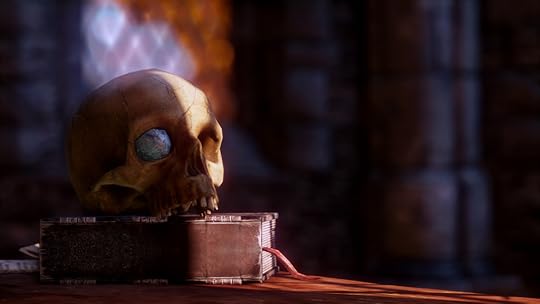 Photo credit: .Natty.Dread. on Flickr
Photo credit: .Natty.Dread. on Flickr
Magic, dragons, elves, wizards, witches, portals, fairies, mages—anything goes in a fantasy novel. These books are built off fantastical worlds where the impossible is impossible and where the mythical is reality.
Examples: A Game of Thrones by George R.R. Martin, The Lord of the Rings by J.R.R. Tolkien, Harry Potter by J.K. Rowling, Half Bad by Sally Green, The Witch Hunter by Virginia Boecker, The Queen of Tearling by Erika Johansen, Red Queen by Victoria Aveyard, Throne of Glass by Sarah J. Maas, Shadow and Bone by Leigh Bardugo, The Girl of Fire and Thorns by Rae Carson, Graceling by Kristin Cashore.
For more info on writing fantasy, check out this post. (Others)
Paranormal
 Photo credit: gaelx on Flickr
Photo credit: gaelx on Flickr
Technically this is a subgenera of fantasy, but it’s so big I thought it merited it’s own category. Paranormal books are a step closer to reality than epic fantasies, but they include supernatural creatures like angels, vampires, fairies, ghosts, werewolves, shapeshifters, etc. Think the TV show Supernatural.
Examples: Twilight by Stephanie Meyer, Ink by Amanda Sun, The Unbecoming of Mara Dyer by Michelle Hodkin, Shiver and The Raven Boys by Maggie Stiefvater, The Coldest Girl in Coldtown by Holly Black, The Diviners by Libba Bray, Paranormalcy by Kiersten White, Hush, Hush by Becca Fitzpatrick, The Immortal Rules by Julie Kagawa. (Others)
For more info on writing paranormal, check out this post.
Science Fiction (Sci-Fi)
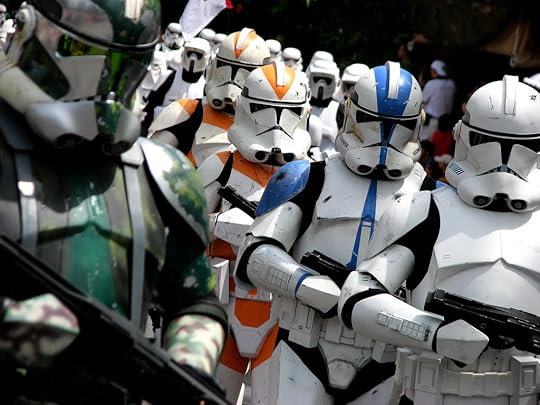 Photo credit: Scott Smith (SRisonS) on Flickr
Photo credit: Scott Smith (SRisonS) on Flickr
Science Fiction is similar to fantasy in that the worlds and situations aren’t real (at the time they are written, at least), but the so-called “fantastical” elements are based in science, rather than magic. The idea here is the made-up stuff could be real, scientifically-speaking. It’s just not real right now.
Examples: Across the Universe by Beth Revis, Salvage by Alexandra Duncan, The 5th Wave by Rick Yancey, The Martian by Andy Weir, The Cage by Megan Shepherd, The Edge of Forever by Melissa E. Hurst, Cinder by Marissa Meyer, These Broken Stars by Amie Kaufman and Meagan Spooner, Alienated by Melissa Landers. (Others)
For more info on writing sci-fi, check out this post.
Dystopia
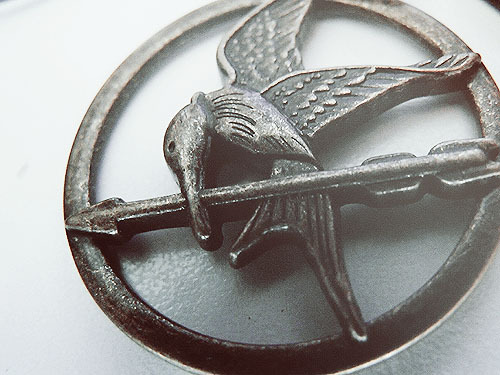 Photo credit: playingdead on FlickrDystopian novels are a subgenre of Sci-Fi, but as they’ve gotten pretty huge on their own, it felt important to list them separately. Dystopian novels frequently feature futuristic oppressive governments that are often overthrown at the end of the book. Expect speculative societies with extremely strict rules and characters who unwittingly find themselves at the center of a revolution (though that isn’t always the case).
Photo credit: playingdead on FlickrDystopian novels are a subgenre of Sci-Fi, but as they’ve gotten pretty huge on their own, it felt important to list them separately. Dystopian novels frequently feature futuristic oppressive governments that are often overthrown at the end of the book. Expect speculative societies with extremely strict rules and characters who unwittingly find themselves at the center of a revolution (though that isn’t always the case).
Examples: Brave New World by Aldous Huxley, Divergent by Veronica Roth, The Hunger Games by Suzanne Collins, The Murder Complex by Lindsay Cummings, Under the Never Sky by Veronica Rossi, The Choosing by Rachelle Dekker, Red Rising by Pierce Brown, Ready Player One by Ernest Cline, The 100 by Kass Morgan, The Selection by Kiera Cass, Shatter Me by Tahereh Mafi, Legend by Marie Lu, Matched by Ally Condie. (Others)
For more info on writing dystopias, check out this post.
Horror
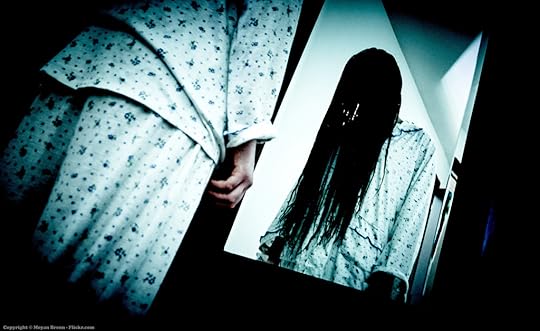 Photo credit: Moyan Brenn on FlickrThese books are written to scare. Or at least creep you out a little. Monsters, murderers, paranormal situations out to get you—these characters usually go through horrifying situations that end in a lot of people dying in terrible ways.
Photo credit: Moyan Brenn on FlickrThese books are written to scare. Or at least creep you out a little. Monsters, murderers, paranormal situations out to get you—these characters usually go through horrifying situations that end in a lot of people dying in terrible ways.
Examples: Rot and Ruin by Jonathan Maberry, Follow You Home by Mark Edwards, Ten by Gretchen McNeil, Sweet by Emmy Laybourne, House by Ted Dekker and Frank Peretti, The Enemy by Charlie Higson, Anna Dressed in Blood by Kendare Blake, Feed by Mira Grant, World War Z by Max Brooks, anything written by Stephen King, The Silence of the Lambs by Thomas Harris. (Others)
Thriller
 Photo credit: @lattefarsan on Flickr
Photo credit: @lattefarsan on Flickr
Thrillers are similar to horror, but here, it tends to be about a killer going after people (rather than something supernatural). Sometimes the two blend a little, but these are exciting, fast-paced novels where the threat of death is a constant.
Examples: Hushed by Kelley York, Gone Girl by Gillian Flynn, Black Iris by Leah Raeder, Luckiest Girl Alive by Jessica Knoll, Thr3e and Adam by Ted Dekker, The Girl on the Train by Paula Hawkins, The Devil You Know by Trish Doller, Delicate Monsters by Stephanie Keuhn, The Rules by Nancy Holder and Debbie Viguié. (Others)
Humor
 Photo credit: Arnett Gill on FlickrThese books are funny. The point is to tell a story that makes you laugh quite a bit. These are often written by celebrities, and when they’re not they tend to also cross into other genres. So yes.
Photo credit: Arnett Gill on FlickrThese books are funny. The point is to tell a story that makes you laugh quite a bit. These are often written by celebrities, and when they’re not they tend to also cross into other genres. So yes.
Examples: Me Talk Pretty One Day by David Sedaris, Yes Please by Amy Poehler, Is Everyone Hanging Out Without Me? (And Other Concerns) by Mindy Kaling, Beauty Queens by Libba Bray, Me and Earl and the Dying Girl by Jesse Andrews, Denton’s Little Deathdate by Lance Rubin, Hyperbole and a Half: Unfortunate Situations, Flawed Coping Mechanisms, Mayhem, and Other Things That Happened by Allie Brosh. (Others)
So that’s just the first part! I’ll finish part two for you guys shortly. :)
Twitter-sized bite:





So! I thought I’d create what was supposed to be a mini index of the major genres. Except the post was getting way too long, so I split it into two. Enjoy part one!
Fantasy
 Photo credit: .Natty.Dread. on Flickr
Photo credit: .Natty.Dread. on FlickrMagic, dragons, elves, wizards, witches, portals, fairies, mages—anything goes in a fantasy novel. These books are built off fantastical worlds where the impossible is impossible and where the mythical is reality.
Examples: A Game of Thrones by George R.R. Martin, The Lord of the Rings by J.R.R. Tolkien, Harry Potter by J.K. Rowling, Half Bad by Sally Green, The Witch Hunter by Virginia Boecker, The Queen of Tearling by Erika Johansen, Red Queen by Victoria Aveyard, Throne of Glass by Sarah J. Maas, Shadow and Bone by Leigh Bardugo, The Girl of Fire and Thorns by Rae Carson, Graceling by Kristin Cashore.
For more info on writing fantasy, check out this post. (Others)
Paranormal
 Photo credit: gaelx on Flickr
Photo credit: gaelx on FlickrTechnically this is a subgenera of fantasy, but it’s so big I thought it merited it’s own category. Paranormal books are a step closer to reality than epic fantasies, but they include supernatural creatures like angels, vampires, fairies, ghosts, werewolves, shapeshifters, etc. Think the TV show Supernatural.
Examples: Twilight by Stephanie Meyer, Ink by Amanda Sun, The Unbecoming of Mara Dyer by Michelle Hodkin, Shiver and The Raven Boys by Maggie Stiefvater, The Coldest Girl in Coldtown by Holly Black, The Diviners by Libba Bray, Paranormalcy by Kiersten White, Hush, Hush by Becca Fitzpatrick, The Immortal Rules by Julie Kagawa. (Others)
For more info on writing paranormal, check out this post.
Science Fiction (Sci-Fi)
 Photo credit: Scott Smith (SRisonS) on Flickr
Photo credit: Scott Smith (SRisonS) on FlickrScience Fiction is similar to fantasy in that the worlds and situations aren’t real (at the time they are written, at least), but the so-called “fantastical” elements are based in science, rather than magic. The idea here is the made-up stuff could be real, scientifically-speaking. It’s just not real right now.
Examples: Across the Universe by Beth Revis, Salvage by Alexandra Duncan, The 5th Wave by Rick Yancey, The Martian by Andy Weir, The Cage by Megan Shepherd, The Edge of Forever by Melissa E. Hurst, Cinder by Marissa Meyer, These Broken Stars by Amie Kaufman and Meagan Spooner, Alienated by Melissa Landers. (Others)
For more info on writing sci-fi, check out this post.
Dystopia
 Photo credit: playingdead on FlickrDystopian novels are a subgenre of Sci-Fi, but as they’ve gotten pretty huge on their own, it felt important to list them separately. Dystopian novels frequently feature futuristic oppressive governments that are often overthrown at the end of the book. Expect speculative societies with extremely strict rules and characters who unwittingly find themselves at the center of a revolution (though that isn’t always the case).
Photo credit: playingdead on FlickrDystopian novels are a subgenre of Sci-Fi, but as they’ve gotten pretty huge on their own, it felt important to list them separately. Dystopian novels frequently feature futuristic oppressive governments that are often overthrown at the end of the book. Expect speculative societies with extremely strict rules and characters who unwittingly find themselves at the center of a revolution (though that isn’t always the case). Examples: Brave New World by Aldous Huxley, Divergent by Veronica Roth, The Hunger Games by Suzanne Collins, The Murder Complex by Lindsay Cummings, Under the Never Sky by Veronica Rossi, The Choosing by Rachelle Dekker, Red Rising by Pierce Brown, Ready Player One by Ernest Cline, The 100 by Kass Morgan, The Selection by Kiera Cass, Shatter Me by Tahereh Mafi, Legend by Marie Lu, Matched by Ally Condie. (Others)
For more info on writing dystopias, check out this post.
Horror
 Photo credit: Moyan Brenn on FlickrThese books are written to scare. Or at least creep you out a little. Monsters, murderers, paranormal situations out to get you—these characters usually go through horrifying situations that end in a lot of people dying in terrible ways.
Photo credit: Moyan Brenn on FlickrThese books are written to scare. Or at least creep you out a little. Monsters, murderers, paranormal situations out to get you—these characters usually go through horrifying situations that end in a lot of people dying in terrible ways. Examples: Rot and Ruin by Jonathan Maberry, Follow You Home by Mark Edwards, Ten by Gretchen McNeil, Sweet by Emmy Laybourne, House by Ted Dekker and Frank Peretti, The Enemy by Charlie Higson, Anna Dressed in Blood by Kendare Blake, Feed by Mira Grant, World War Z by Max Brooks, anything written by Stephen King, The Silence of the Lambs by Thomas Harris. (Others)
Thriller
 Photo credit: @lattefarsan on Flickr
Photo credit: @lattefarsan on FlickrThrillers are similar to horror, but here, it tends to be about a killer going after people (rather than something supernatural). Sometimes the two blend a little, but these are exciting, fast-paced novels where the threat of death is a constant.
Examples: Hushed by Kelley York, Gone Girl by Gillian Flynn, Black Iris by Leah Raeder, Luckiest Girl Alive by Jessica Knoll, Thr3e and Adam by Ted Dekker, The Girl on the Train by Paula Hawkins, The Devil You Know by Trish Doller, Delicate Monsters by Stephanie Keuhn, The Rules by Nancy Holder and Debbie Viguié. (Others)
Humor
 Photo credit: Arnett Gill on FlickrThese books are funny. The point is to tell a story that makes you laugh quite a bit. These are often written by celebrities, and when they’re not they tend to also cross into other genres. So yes.
Photo credit: Arnett Gill on FlickrThese books are funny. The point is to tell a story that makes you laugh quite a bit. These are often written by celebrities, and when they’re not they tend to also cross into other genres. So yes. Examples: Me Talk Pretty One Day by David Sedaris, Yes Please by Amy Poehler, Is Everyone Hanging Out Without Me? (And Other Concerns) by Mindy Kaling, Beauty Queens by Libba Bray, Me and Earl and the Dying Girl by Jesse Andrews, Denton’s Little Deathdate by Lance Rubin, Hyperbole and a Half: Unfortunate Situations, Flawed Coping Mechanisms, Mayhem, and Other Things That Happened by Allie Brosh. (Others)
So that’s just the first part! I’ll finish part two for you guys shortly. :)
Twitter-sized bite:
Do you find genres confusing? @Ava_Jae breaks down some of the most common genres in today's post. (Click to tweet)





Published on July 20, 2015 04:00
July 17, 2015
Fixing the First Page Feature Giveaway #13
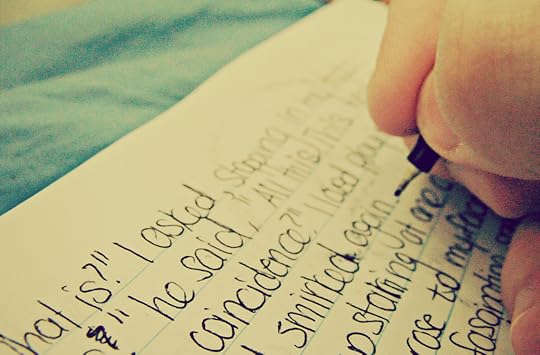 Photo credit: Nellie0224 on FlickrIncredibly, we are more than halfway through July, which means it's time to gear up for the next Fixing the First Page giveaway! Yay!
Photo credit: Nellie0224 on FlickrIncredibly, we are more than halfway through July, which means it's time to gear up for the next Fixing the First Page giveaway! Yay!For those who’ve missed it in the past, the Fixing the First Page features is a public first 250 word critique. Using the lovely rafflecopter widget, anyone interested in winning a PUBLIC (as in, featured in a post on this blog) first page critique can enter.
For an example of what this critique will look like, here's the last Fixing the First Page post.
Rules!
ONLY the first 250 words will be critiqued (up to finishing the sentence). If you win and send me more, I will crop it myself. No exceptions.
ONLY the first page. I don’t want 250 random words from your manuscript, or from chapter 3. If you win the critique and send me anything other than the first 250 words of your manuscript, I will choose someone else.
I will actually critique it. Here. On the blog. I will say things as nicely as I can, but I do tend to be a little blunt. If you’re not sure you can handle a public critique, then you may want to take some time to think about it before you enter.
Genre restrictions. I'm most experienced with YA & NA, but I will still accept MG and Adult. HOWEVER. If your first page has any erotic content on it, I ask that you don’t enter. I want to be able to post the critique and the first 250 in its entirety without making anyone uncomfortable, and if you win and you enter a page with erotic content, I will choose someone else.
You must have your first page ready. Should you win, you need to be able to submit your first page within 48 hours of my contacting you to let you know you won. If 48 hours pass and I haven’t heard from you, again, I will choose someone else.
You’ll get the most out of this if it isn’t a first draft. Obviously, I have no way of knowing if you’re handing me a first draft (though I will probably suspect because it’s usually not that difficult to tell). I won’t refuse your page if it’s a first draft, but you should know that this critique will likely be of more use if you’ve already had your betas/CPs look over it. Why? Because if you don’t, the critique I give you will probably contain a lot of notes that your betas & CPs could have/would have told you.
There will not be a round 2 (unless you win again in a future contest). I hate to have to say this, but if you win a critique, it’s NOT an invitation to send me a bunch of your revisions. I wish I had the time available to be able to look at revisions, but sadly, I don’t. If you try to break this rule, I will nicely say no, and also remember to choose someone else should you win a second contest. Which would make me sad. :(
So that’s it! If you’re okay with all of the above and would like to enter to be the twelfth public critique on Writability, do the thing with the rafflecopter widget below. You have until Wednesday, July 22 at 11:59 EST to enter!
a Rafflecopter giveaway





Published on July 17, 2015 04:00
July 15, 2015
Discussion: How Long Do You Let Your WIPs Cool?
 Photo credit: Alessandro Lorizzo on FlickrSo many a year ago, I wrote about the importance of letting your manuscripts cool between finishing the first draft and starting the first read through. And while I do still believe it’s important for many writers for the reasons I listed in that post, my process has a changed a little since getting agented.
Photo credit: Alessandro Lorizzo on FlickrSo many a year ago, I wrote about the importance of letting your manuscripts cool between finishing the first draft and starting the first read through. And while I do still believe it’s important for many writers for the reasons I listed in that post, my process has a changed a little since getting agented.It used to be when I finished a first draft, I’d put it away and eagerly wait a month before looking at it again. This worked well when I was working on one project at a time, at thirty or so days gave me enough distance to then look at the writing more critically than I would have had I started reading right after first drafting.
A month worked really well for ages up until last year when a couple things happened:
I signed with my agent (yay!) We sold Beyond the Red (YAY!) I wrote two first drafts back to back (oh…kay?) I looked at my NaNo MS from 2013 and knew I couldn’t just leave it. I maybe sort of pitched a bunch of books to my agent and suddenly I was juggling a bunch of projects. (Yay? Yay!)
So now I had all of these manuscripts and after working out a good order for which manuscript would get attention first, I realized all of the projects would be getting wayyyyy more than a month-long cooling off period.
First came the #NerdyWIP I’ve talked about, which had a cooling off period of…five or six months? Something like that.
Then the #YAFantasyWIP got a ton of love after sitting in the drawer for well over a year.
And now I’ll be turning to the second MS I drafted last summer, just about a year later.
Waiting this much longer, even unintentionally, has its perks. When I go back to those WIPs, I’m usually pretty darn excited because I’ve been waiting so long to get back to them, and I also remember very little about them which may not sound like a perk, but actually makes it so much easier to look at not just the writing critically, but the plot, and characters, and everything else.
So lately that’s what I’ve been doing. And while this may very well change with circumstance, it’s been an interesting schedule to work with.
So how about you? How long do you let your WIPs cool before the first read through?
Twitter-sized bite:
How long do you let your WIP cool between 1st drafting & 1st read through? Join the discussion on @Ava_Jae's blog. (Click to tweet)





Published on July 15, 2015 04:00
July 14, 2015
Vlog: How to Finish a WIP
You asked, I answered: how do you finish a work in progress when you frequently get stuck?
RELATED LINKS:
How to Finish Writing a NovelDiscussion: Do You Finish Every Novel Idea You Start?
Twitter-sized bites:





RELATED LINKS:
How to Finish Writing a NovelDiscussion: Do You Finish Every Novel Idea You Start?
Twitter-sized bites:
"Sometimes an idea isn't meant to be. And that's okay." #writetip (Click to tweet)
How do you finish a WIP when you frequently get stuck? @Ava_Jae vlogs her thoughts. (Click to tweet)





Published on July 14, 2015 08:09
July 13, 2015
On Developing Characters
 Photo credit: notfrancois on FlickrFun fact: after I’ve finished plotting a potential book from start to finish and I’ve prepared everything I need to to start writing, I know very little about my characters.
Photo credit: notfrancois on FlickrFun fact: after I’ve finished plotting a potential book from start to finish and I’ve prepared everything I need to to start writing, I know very little about my characters.I mean, when it comes to my protagonist and love interest(s), I know super basics like name and physical description, but if I’ve fleshed out any personality at all it’s usually only a really vague idea, if anything.
The truth is, I don’t really get to know my characters until I’ve started first drafting—and that also goes for my protagonist. And for me, this where the fun almost-pantsing comes in—because while I know pretty much how the plot is going to lay out, I don’t really know how my characters are going to develop, at least, not in the first draft.
This is also why I don’t call a WIP a WIP until I’ve hit 10,000 words—I have, on more than one occasion, started writing a totally solid idea then put it away because the protagonist’s voice just didn’t sit with me. But that’s something I really can’t predict until I’ve started writing.
There are a few things my protagonists tend to have in common: they’re often snarky because I’m a snarkmonster IRL, they’re often internally conflicted because I love writing internal conflict, and many times they’re outcasts of some sort, because I love writing characters on the fringe of society.
But honestly? That stuff can manifest in limitless ways, and there’s still so much room for drastically different personalities, and ways of speaking and thinking and viewing the world. And I love figuring it out along the way, and I never tire of having a protagonist surprise me with a stray thought, or memory, or off-handed comment, or unexpected action that I never could have predicted from day one.
In later drafts is where I then take those personality seeds and push them further. It’s where I dig into characters and unearth the stuff the first draft hinted at—it’s where I push them harder to be raw and real.
Unlike plotting, I tend to develop my characters really instinctively. From a wisp of an idea upon character conception to a fully-developed, layered character over time.
And that’s how I develop my characters. How do you develop yours?
Twitter-sized bite:
Writer @Ava_Jae shares how she develops characters instinctively. What does character development look like for you? (Click to tweet)





Published on July 13, 2015 04:00

